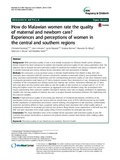How do Malawian women rate the quality of maternal and newborn care? : experiences and perceptions of women in the central and southern regions
Date
2015-04Publisher
© 2015 BMC Pregnancy & ChildbirthAuthor
Kambala, ChristabelLohmann, Julia
Mazalale, Jacob
Brenner, Stephan
Allegri, Manuela De
Muula, Adamson S.
Sarker, Malabika
Metadata
Show full item recordCitation
Kambala, C., Lohmann, J., Mazalale, J., Brenner, S., De Allegri, M., Muula, A. S., & Sarker, M. (2015). How do Malawian women rate the quality of maternal and newborn care? Experiences and perceptions of women in the central and southern regions. BMC Pregnancy & Childbirth, 15(1), 169. http://doi.org/10.1186/s12884-015-0560-xAbstract
Background: While perceived quality of care is now widely recognized to influence health service utilization,
limited research has been conducted to explore and measure perceived quality of care using quantitative tools. Our
objective was to measure women’s perceived quality of maternal and newborn care using a composite scale and
to identify individual and service delivery factors associated with such perceptions in Malawi.
Methods: We conducted a cross-sectional survey in selected health facilities from March to May 2013. Exit
interviews were conducted with 821 women convenience sampled at antenatal, delivery, and postnatal clinics
using structured questionnaires. Experiences and the corresponding perceived quality of care were measured using
a composite perception scale based on 27 items, clustered around three dimensions of care: interpersonal relations,
conditions of the consultation and delivery rooms, and nursing care services. Statements reflecting the 27 items
were read aloud and the women were asked to rate the quality of care received on a visual scale of 1 to 10 (10
being the highest score). For each dimension, an aggregate score was calculated using the un-weighted item
means, representing three outcome variables. Descriptive statistics were used to display distribution of explanatory
variables and one-way analysis of variance was used to analyse bivariate associations between the explanatory and
the outcome variables.
Results: A high perceived quality of care rating was observed on interpersonal relations, conditions of the
examination rooms and nursing care services with an overall mean score of 9/10. Self-introduction by the health
worker, explanation of examination procedures, consent seeking, encouragement to ask questions, confidentiality
protection and being offered to have a guardian during delivery were associated with a high quality rating of
interpersonal relations for antenatal and delivery care services. Being literate, never experienced a still birth and, first
ANC visit were associated with a high quality rating of room conditions for antenatal care service.
Conclusions: The study highlights some of the multiple factors associated with perceived quality of care. We
conclude that proper interventions or practices and policies should consider these factors when making quality
improvements.
Description
Includes bibliographical references (page 18-19).Department
James P Grant School of Public Health, BRAC UniversityType
ArticleCollections
- Article [16]
- Faculty Publications [111]
- Journal Articles (2015) [9]

